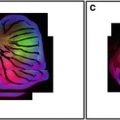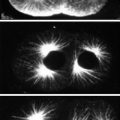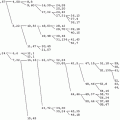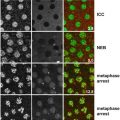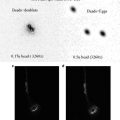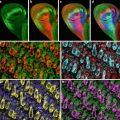(1)
IP Coyle Intellectual Property Agency, Fort Lauderdale, FL, USA
Abstract
The Drosophila larval neuromuscular junction (NMJ) consists of a presynaptic motor neuron terminal and a postsynaptic muscle cell that offer an accessible and popular model system for the analysis of synaptic growth and function. I describe techniques for visualizing fluorescently labeled proteins within dissected, formaldehyde-fixed second to third instar larval NMJs. In addition, I present two strategies using confocal microscopy to solve a particular problem in NMJ analysis: distinguishing fluorescence in the presynaptic nerve terminal from that in the adjacent postsynaptic muscle cell. This problem arises from the fact that the membrane of the muscle cell envelops the motor neuron terminal with a convoluted process called the subsynaptic reticulum, obscuring the boundary between muscle and nerve. A first strategy entails taking thin optical sections through synaptic boutons to capture a cross section of the nerve terminal, and a second strategy involves visualizing epitope-tagged isoforms of particular proteins that have been transgenically expressed in either the nerve or the muscle.
Key words
Drosophila neuromuscular junctionPeriactive zoneSynaptic boutonSubsynaptic reticulumEpitope tagNervous wreckPak1 Introduction
Extensive molecular analyses of synaptic growth and function have been performed at the larval neuromuscular junctions (NMJs) of Drosophila melanogaster [1–4]. This system is popular because many of the synaptic proteins present within Drosophila NMJs have homologs in the vertebrate CNS and because the motor axons of third instar larvae form large, accessible contacts on the surfaces of the body wall muscles. Fluorescence immunocytochemistry combined with confocal microscopy make it possible to visualize the subcellular localization of synaptic proteins at ~0.2 μm horizontal resolution in the NMJs of fixed, eviscerated larvae. Moreover, confocal microscopy is being used for live imaging of nerve growth and synaptic vesicle dynamics in either dissected or undissected larvae, discussed elsewhere [5–8]. These studies are enhanced by the genetic tractability of Drosophila, because epitope- or reporter-tagged chimeras can be expressed specifically in the presynaptic neuron, the postsynaptic muscle cell, or both. This not only facilitates labeling of subcellular compartments in nerve terminals but also permits visualizing the localization of putative synaptic proteins when specific antisera are not available.
High-resolution confocal analysis of the larval NMJ has helped identify discrete functional domains within synapses. For example, numerous cell signaling molecules that regulate NMJ growth, such as Fasciclin II (FasII) or nervous wreck (Nwk), are found in a network of doughnut-like rings around active zones, collectively called the “periactive zone” within the presynaptic nerve terminal [9–11]. In contrast, “active zones,” which contain the proteins necessary for neurotransmitter release, such as voltage-gated calcium channels [12, 13], are clustered in a counterpattern of distinct puncta. Such subcellular organization indicates that the factors involved in exocytosis, endocytosis, and cytoskeletal dynamics are grouped in distinct microdomains [14–16]. These observations not only help illustrate synaptic architecture but also make it possible to infer the functions of novel synaptic proteins based on their subcellular localization.
Despite the relatively detailed resolution that has been achieved through confocal analysis at the Drosophila NMJ, a caveat arises when attempting to visualize the subcellular localization of proteins that are expressed both pre- and postsynaptically, such as actin and many cytoskeleton-associated proteins. This problem stems from the fact that the presynaptic nerve terminal is enveloped by a convoluted extension of the muscle membrane called the subsynaptic reticulum (SSR) [17]. If a protein were expressed in the SSR, its signal may obscure the presence and distribution of the same protein expressed in the underlying nerve. Taking thin optical sections through the nerve terminal can delimit the presynaptic cytosol in some cases. However, if the protein were membrane associated, the presynaptic and postsynaptic complement may be situated as close as 20 nm apart, below the resolution of confocal light microscopy. In such instances, epitope (i.e., HA or c-Myc) or reporter (i.e., GFP) tags can assist the analysis because chimeric proteins incorporating such tags can be expressed exclusively within nerves or muscle cells using the UAS-GAL4 system and subsequently visualized using fluorescent antibodies directed against the tag or via autofluorescence of the tag itself.
2 Materials
2.1 Larval Dissection and Fixation
1.
2.
Calcium-free saline (128 mM NaCl, 2 mM KCl, 4 mM MgCl2-6H2O, 35.5 mM sucrose, 5 mM HEPES, 1 mM EGTA).
3.
Insect dissecting chambers [19] and pins. Dissections can also be performed using insect pins in Falcon 35 mm Petri dishes coated with Sylgard resin.
4.
Forceps and small scissors or scalpel.
5.
Dissection microscope.
6.
4 % paraformaldehyde fixative (PFA) in phosphate buffered saline, pH 7.4.
(a)
Mix 20 ml of 0.5 M dibasic sodium phosphate (Na2HPO4) and 80 ml ddH2O in a 200 ml beaker
(b)
Add 8 g paraformaldehyde (Sigma) and ~200 mg NaOH or two pellets (Mallinckrodt).
(c)
Seal beaker with paraffin and mix well on a hot plate in a flow hood at ~75 °C for 15 min. Avoid boiling, which generates formic acid.
(d)
Separately, mix 20 ml 0.5 M monobasic sodium phosphate (NaH2PO4) with 80 ml ddH20.
(e)
After 15 min, the formaldehyde solution becomes nearly translucent. Add all 100 ml of the monobasic sodium phosphate dilution. Verify that solution is ~pH 7.4 using litmus strips (MCB reagents).
(f)
Add 2 ml of 50 mM EGTA (0.5 μM final concentration).
(g)
Gravity filter with Whatman filter paper. The fixative is usable for up to 3 weeks if refrigerated.
2.2 Larval Staining
2.
Blocking solution (PBTX, 3 % bovine serum albumen); optional.
3.
Microscope slides, glass coverslips, Vectashield mounting medium (Vector laboratories), and nail polish.
4.
Primary antisera (see Table 1).
Table 1
Antisera for NMJ markers
Pattern | Reagent (source) | Final dilution |
|---|---|---|
All insect nerves | Anti-HRP (Molecular Probes) | 1:200 |
Muscle cells | Fluorophore-conjugated phalloidin (Molecular Probes) | 1:6 |
Periactive zone | Anti-Nwk, rat [11] Anti-fasciclin II, mouse (Hybridoma Banka #1D4) Anti-DAP160, rabbit [20] | 1:500 1:100 1:200 |
Postsynaptic density (PSD) | Anti-Pak, rabbit [21] Anti-GluR2b, mouse (Hybridoma Banka, #8B4D2) | 1:2,000 1:100 |
Subsynaptic reticulum (SSR) | Anti-Dlg, rabbit [22] Anti-Spectrin, mouse [23] | 1:1,000 1:25 |
Epitope tags | Anti-GFP, rabbit (Molecular Probes) Anti-HA 3 F10, rat (Roche Applied Science) Anti-Myc 9E10, mouse (Roche Applied Science) | 1:1,500 1:10 1:10 |
5.
Secondary antisera conjugated to fluorophores. For example, goat anti-rat IgG-conjugated Alexa-568 (Molecular Probes).
2.3 Imaging
Images were acquired with a Bio-Rad MRC 1024 laser scanning confocal apparatus mounted on a Nikon microscope. Images were processed in image J (free from NIH at http://rsb.info.nih.gov/ij/) and Photoshop (Adobe).
3 Methods
3.1 Larval Dissection and Fixation
1.
Dissection. Place a larva in the dissection chamber. Under a dissecting scope, pin larva at the anterior and posterior ends with dorsal surface up. Bathe in calcium-free saline, which will inhibit muscle contraction upon incision. Cut along dorsal midline from pin to pin and remove tissue (i.e., gut, salivary glands, fat bodies, and gonads; see Note 4), leaving brain intact and avoiding damage to the ventral surface. Using pins, secure the edges of the cuticle on both sides near the head and tail, so it lays flat with its interior surface exposed. The nerves and muscles are attached to this surface. For a detailed protocol, see ref. 19.
2.
Fixation. Pipette out the calcium-free saline and quickly replace with 4 % PFA. Incubate on a gently rotating platform (~50 RPM) for 15–60 min (precise time required varies with different antibodies/epitopes).
3.
Washes. Unpin the larva and transfer to a watch glass or small volume (<1 ml) tube using forceps. Wash three times for 15 min each with PBTX or a phosphate buffer that contains a detergent compatible with your antisera.
3.2 Larval Staining
Each primary antiserum must be used at an empirically determined concentration, with monoclonals generally requiring a higher titer than polyclonals (see Table 1). Fluorophore-conjugated secondary antibodies are commonly applied at a final concentration of 1:200. Use small incubation volumes to conserve precious antisera.
1.
(Optional) Block 30 min in blocking solution at room temperature with gentle agitation (~50 RPM on a flat rotator).
2.
Incubate the larvae in PBTX or fresh blocking solution for 2 h at room temperature with the appropriate concentration(s) of primary antisera. I prefer to incubate in ~100 μl PBTX in a watch glass covered with a glass slide at 4 °C overnight and then for 1 h at room temp on the rocker at 50 RPM. 1 ml Eppendorfs may be used instead of a watch glass. In any case, make sure the vessel is covered to prevent evaporation.
3.
Wash three times for 15 min each in PBTX.
4.
Repeat step 2 with secondary antisera. From this point onward, keep samples protected from light, which will attenuate the fluorophores.
5.
Wash four times for 15 min each in PBTX.
6.




Mounting. Transfer larvae to a glass slide with forceps so that the interior surface faces up. It may be necessary to gently unfold the edges of the cuticle using forceps to get it flat. Wick away excess PBTX using a Kimwipe (twist a corner into a wick and hold it next to the larva on the slide for 2 s) and cover the prep with a small drop of Vectashield mounting medium. Add a cover slip, gently pressing it straight downwards to flatten the larva without crushing it or shearing it. Wipe away excess Vectashield and seal the edges of the coverslip completely with nail polish.
Stay updated, free articles. Join our Telegram channel

Full access? Get Clinical Tree



